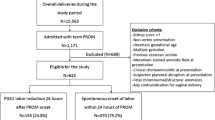Abstract
Introduction
Premature rupture of membrane is managed either expectantly or actively. The purpose of the study was to assess the effectiveness of early labor induction with cervical prostaglandin E2 versus expectant management in women with term premature rupture of membrane.
Material and Methods
Singleton pregnancy cases with cephalic presentation reported between 37 and 41 weeks of pregnancy with PROM of <6 h and cervical dilatation <3 cm were studied over a period of 2 years. Out of 100 patients studied, half of them were managed by expectant protocol and the other half by early induction within 6 h of PROM with intracervical gel. Main outcomes measured were PROM–delivery interval, mode of delivery, neonatal and maternal morbidity, and period of maternal and/or neonatal hospitalization. Chi-square test was used to compare frequencies between two groups. Differences between means of other measurement were compared by independent t test.
Results
PROM–delivery interval was 22 h in expectant group, while in early induction group, it was 13 h (p value < 0.001). Rate of cesarean section remained almost same in both groups. Increases in maternal–neonatal infection rate and hospital stay were noted in expectant group; however, this was not statistically significant.
Conclusion
Immediate labor induction with prostaglandin in cases of term PROM shortens delivery interval and maternal hospital stay with reduction in maternal–neonatal sepsis.
Similar content being viewed by others
References
Larranaga-Azcarate C, Campo-Molina G, Perez-Rodríguez AF et al. Dinoprostone vaginal slow release system compared to expectant management in the active treatment of premature rupture of the membranes at term: impact on maternal and fetal outcome. Acta obstetrica. 2008;87:195–200.
Duff P. Premature rupture of membranes in term patients: induction of labor versus expectant management. Clin Obstet Gynecol. 1998;41:883–91.
Ozden S, Delikara MN, Avci A et al. Intravaginal misoprostol vs expectant management in premature rupture of membranes with low bishop scores at term. Int J gynaecol obstet. 2002;77:109–15.
Hoffmann RA, Anthony J, Fawcus S. Oral misoprostol vs. placebo in the management of prelabor rupture of membranes at term: Int J of gynec obstet. 2001;72:215–21.
Ayaz A, Saeed S, Farooq MU et al. Pre-labor rupture of membranes at term in patients with an unfavorable cervix: active versus conservative management. Taiwan J obstet gynecol. 2008;47:192–6.
da Graca krupa F, Cecatti JG, de Castro Surita FG et al. Misoprostol versus expectant management in premature rupture of membranes at term. BJOG. 2005;112:1284–90.
Akyol D, Mungan T, Unsal A et al. Prelabour rupture of membranes at term: no advantage of delaying induction for 24 hours. Aust N Z J Obstet Gynecol. 1999;39:291–5.
Dare MR, Middleton P, Crowther CA et al. Planned early birth versus expectant management (waiting) for prelabour rupture of membranes at term (37 weeks or more). Cochrane Database Syst Rev. 2006;1:CD005302.
Author information
Authors and Affiliations
Corresponding author
Rights and permissions
About this article
Cite this article
Shah, K., Doshi, H. Premature Rupture of Membrane at Term: Early Induction Versus Expectant Management. J Obstet Gynecol India 62, 172–175 (2012). https://doi.org/10.1007/s13224-012-0172-6
Received:
Accepted:
Published:
Issue Date:
DOI: https://doi.org/10.1007/s13224-012-0172-6




